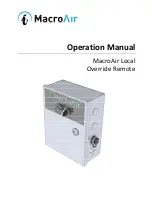
Twin City Engineering Supplement ES-191
5
Blade Adjustment on Adjustable Pitch
Vaneaxial Type TCVX
Blade Angle Adjustment
The blades are set at the factory to the blade angle
that gives the performance specified on the order. This
angle should be checked prior to start-up. The patented
wheel construction uses friction and centrifugal force to
hold the blades in place. No disassembly of the wheel is
required to change the blade angles. If it is necessary to
change the blade angle, the following procedure should
be used:
1. Work safely. Make sure that proper safety precautions
have been followed. Electrical power must be locked
off.
2. The adjustment can be made through the inlet on
open inlet fans. On fans with ducted inlets, open the
wheel area access door.
3. Place adjustment tool around end of blade (see
Figure 6, to the right). If necessary, apply “cheater
bar” around the 1
1
⁄
4
" diameter end for additional
leverage.
The blades can be turned by hand on open inlet
fans. If additional leverage is needed, place a wrench
on the leading edge of the blade near the hub. Take
care not to mar the surface of the blade.
4.
Prior to adjusting the blade angle, check the
performance data to insure that the motor will not
overload.
5. Turn blade to desired angle. See Figure 6. There is
an indicator mark on the hub. Align the Vernier index
line on the blade with the indicator mark on the
hub. The Vernier has the characters 3, 4, and 5 with
gradation lines in between. (
Note: Character 3 is 30°,
4 is 40°, 5 is 50°.) Each gradation is 2.5°. The blade
is adjustable between 25° and 50°.
6. Friction and centrifugal force will hold the blade at
the set angle. No additional adjustment is necessary.
7.
Adjust all blades to the same angle.
8. Close the wheel area access door before operating
the fan.
5
4
3
Tool AS-14093
Blade Tip
Cheater Bar
Hub
Blade
Leading Edge
Detail "X"
Blade
Trailing Edge
Detail “X”
Vernier Index Line
(Blade As Shown
Is Adjusted To 35°
)
Figure 6.
25.0"
5.0"
2.5"
5
4
3
Blade
Hub


























